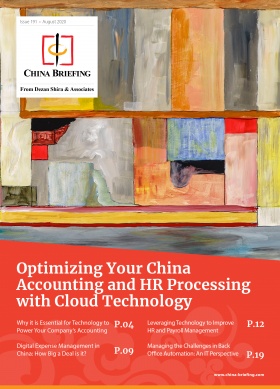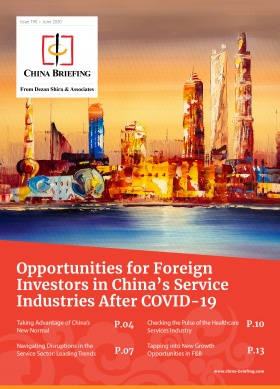Trade Secrets’ Protection in China: What is Changing?
- The market regulator SAMR has released draft provisions on establishing trade secrets’ protection in China.
- These provisions, which have been released into the public domain to collect comments, define what constitutes a trade secret in China and penalty guidelines for violators.
- It is yet another attempt on the part of China to strengthen IP protection in the country, which is key to attracting foreign investment, opening-up high-tech industries, as well as achieving R&D innovation.
On September 4, 2020, China’s State Administration for Market Regulation (“SAMR”) released the Draft Provisions on the Protection of Trade Secrets (“Provisions”) for comments with the aim of strengthening the protection of enterprises’ trade secrets, stopping the infringement of trade secrets, encouraging R&D and innovation, optimizing the business environment, and maintaining fair competition in the market order.
The Provisions intervene on certain important aspects concerning trade secrets and their infringement, already regulated by the Anti-Unfair Competition Law (“AUCL”) – that was adopted September 2, 1993, amended for the first time in 2017, and most recently, on April 23, 2019 – in order to update the relevant legal provisions and enhance the application of the AUCL.
What are trade secrets?
Under the AUCL and clarified by the Provisions – trade secrets are defined as technical, operational, or other commercial information unknown to the public, which is of commercial value for the ‘right’ holder of that information and who has taken corresponding confidentiality measures.
To this regard, the Provisions clarify the notion of trade secrets stating that trade secrets are those “commercial information such as technical information and business information that are not known to the public, have commercial value, and have been subject to appropriate confidentiality measures taken by the right holder”, where “commercial information” refers to any type and form of information related to commercial activities, including but not limited to technical information and business information.
Further, the Provisions specify that technical information refers to the technical solutions obtained by using scientific and technological knowledge, information, and experience, thus including design, procedures, and formulas. On the other hand, the concept of business information refers to all kinds of information related to the business activities of the right holder, including management know-how, customer lists, among other aspects.
For the sake of clarity, the Provisions also delineate what is meant by “commercial value” and what should be considered as “unknown to the public”.
Information with commercial value
Information is considered to have commercial value when it brings either commercial benefits or competitive advantages to the natural persons, legal persons, or unincorporated organizations that have the right to own or use trade secrets (as “right holder”) as long as it is kept as confidential and it is not publicly known.
Information that is unknown to the public
The term ‘unknown to the public’ means that the information is not known to the relevant personnel that work in the field or cannot be easily obtained from public channels. However, there are certain circumstances specifically listed by the Provisions, under which it is excluded that the information is considered as unknown (meaning that under these circumstances, it is assumed that the public know the information):
- The information has been publicly disclosed in publications or other media at home and abroad or has been disclosed through public reports, exhibitions, or otherwise.
- The information has been publicly used at home and abroad.
- The information belongs to the realm of common sense or is generally part of industry practice.
- The information is easily obtained without paying a certain price or can be obtained from other public channels.
- The information is with regard to, for instance, the product size, structure, simple combination of components, or other aspects – that can be obtained by the relevant public through observation, surveying, and disassembling the product after it enters the public domain.
The information must meet specific criteria (as stated earlier) to be considered a trade secret, and if this is the case, the right holder has to take the appropriate measures to keep it confidential and prevent an information leakage.
It is worth noting that, to further guarantee the protection of trade secrets, the Provisions also state that the SAMR’s personnel as well as China’s other state agencies and public servants have a duty of confidentiality regarding trade secrets they may obtain in the course of performing their official duties.
For example, the Provisions state that these state agencies and officials shall not disclose, use, or allow others to use the right holder’s trade secrets beyond the scope of their duties.
What is a trade secrets’ infringement?
According to the AUCL, a trade secrets’ infringement can be either direct, such as through theft, bribery, fraud, coercion, electronic intrusion, or other illicit means or indirect, such as through soliciting, seducing, or assisting others to obtain, disclose, use, or allow a third party to use the trade secrets in violation of their confidentiality obligations or violating the trade secret owner’s confidentiality requirement.
The Provisions confirm the definition of trade secret infringements given by the AUCL, but also provides a non-exhaustive list of the behaviors that lead to such violations –
- dispatching commercial spies to steal business secrets;
- paying or threatening employees or other people to obtain the trade secrets;
- entering the electronic information system of the right holder without authorization or beyond the scope of authorization to obtain trade secrets or planting computer viruses to destroy their trade secrets;
- reproducing or accessing, without authorization, materials or other electronic devices that contain the secrets, or that can be derived from them; and/or
- taking any other improper method in violation of the principle of good faith or business ethics to obtain the right holder’s business secrets.
According to both the AUCL and the Provisions, business operators, individuals, and other entities can be liable for trade secrets’ infringement. What the Provisions specifies, crucially, is what does not constitute an infringement:
- Independent discovery or independent research and development.
- Trade secrets obtained through reverse engineering or similar methods unless trade secrets or products are obtained through improper means or reverse engineering that violates confidentiality obligations.
- Trade secrets obtained by the shareholders by exercising their right to know according to law.
- Disclosure of trade secrets by employees, former employees, or partners of the owner or holder of trade secrets, based on the public interest, national interest to environmental protection, public health, public safety, and disclosure of illegal and criminal activities.
What are the legal liabilities?
The Provisions, with reference to the legal liabilities, directly refer to Article 21 of the AUCL, which states that in case of trade secrets’ infringement, the supervisory inspection department shall order the violator to cease the illegal act, shall confiscate any illegal income, and impose a fine of not less than RMB 100,000 (US$14,757) nor more than RMB 1 million (US$147,581), or if the circumstances are serious, a fine of not less than RMB 500,000 (US$73,789) nor more than RMB 5 million (US$737,898). (USS$1 = RMB 6.77).
According to the Provisions, a violation is deemed to be serious in the following circumstances:
- The right holder losses amount to a sum higher than RMB 500,000;
- Profits gained through the infringement exceed RMB 500,000;
- Causes the right holder’ bankruptcy;
- The violator refuses to compensate the right holder for the losses;
- The electronic intrusion method has caused serious damage to the right holder’s office system network and computer data;
- The infringement caused major economic losses to the country or society, or a bad social impact; and/or
- Other serious acts.
What are the legal liabilities for foreigners in China?
The Provisions, with specific reference to foreigners, state only that the SAMR, as the competent authority to handle trade secrets infringements, may initiate infringement investigations on foreigners’ illegal acquisition, disclosure, and use of the trade secrets of Chinese trade secret owners, order them to stop the infringement, and may also seize the infringing products. Hence, foreign government’s judicial cooperation will play a key role in facilitating discovery and enforcing SAMR or China’s legal judgements.
Looking at the overall legal framework regulating trade secrets, it seems that China is not only strictly complying with the obligations and promises undertaken at the international level – with particular reference to the Phase One Agreement signed with the US – but also suggests that China is building up a solid trade secrets’ protection system.
Indeed, before the above discussed reforms, Chinese legislation did not include electronic intrusions among the means for infringing trade secrets; the plaintiff had to provide evidence to prove the infringement and, consequently, the scope of damage was limited.
Now, thanks to the shift of the burden of proof onto the defendant, the plaintiff shall provide just prima facie evidence, thus being an obligation of the first to prove that the asserted trade secret does not constitute a trade secret under the law.
In simple speak, the defendant has to provide evidence to show that the asserted trade secret is not a trade secret because somehow it does not match the qualifying criteria, and hence must not benefit from the protection given under the AUCL and the Provisions.
Besides this, the clarification of what constitutes a trade secret and the identification of behavior that will be deemed as infringement of trade secrets also help in determining what will be considered punishable under the AUCL and the Provisions.
To this regard, it is worth noting that on September 10, 2020, the Supreme People’s Court issued the Provisions of the Supreme People’s Court on Several Issues Concerning the Application of Law in the Trial of Civil Cases Involving Trade Secret Infringement (effective from September 12, 2020), through which it guides the lower courts in applying the AUCL and the related Provisions, by specifying which are the ways in which such courts will have to implement the new rules.
In conclusion, it will be of utmost importance to monitor the courts’ decisions on future cases involving trade secrets violations, this being the best way to have a better understanding of the practical on-the-ground impact of the new rules on regulating trade secrets and punishing their infringement in China.
About Us
China Briefing is written and produced by Dezan Shira & Associates. The practice assists foreign investors into China and has done so since 1992 through offices in Beijing, Tianjin, Dalian, Qingdao, Shanghai, Hangzhou, Ningbo, Suzhou, Guangzhou, Dongguan, Zhongshan, Shenzhen, and Hong Kong. Please contact the firm for assistance in China at china@dezshira.com.
We also maintain offices assisting foreign investors in Vietnam, Indonesia, Singapore, The Philippines, Malaysia, Thailand, United States, and Italy, in addition to our practices in India and Russia and our trade research facilities along the Belt & Road Initiative.
- Previous Article How to Create a Culture of Sustainability in the Workplace
- Next Article How Beijing is Driving China’s Services Sector Expansion

























